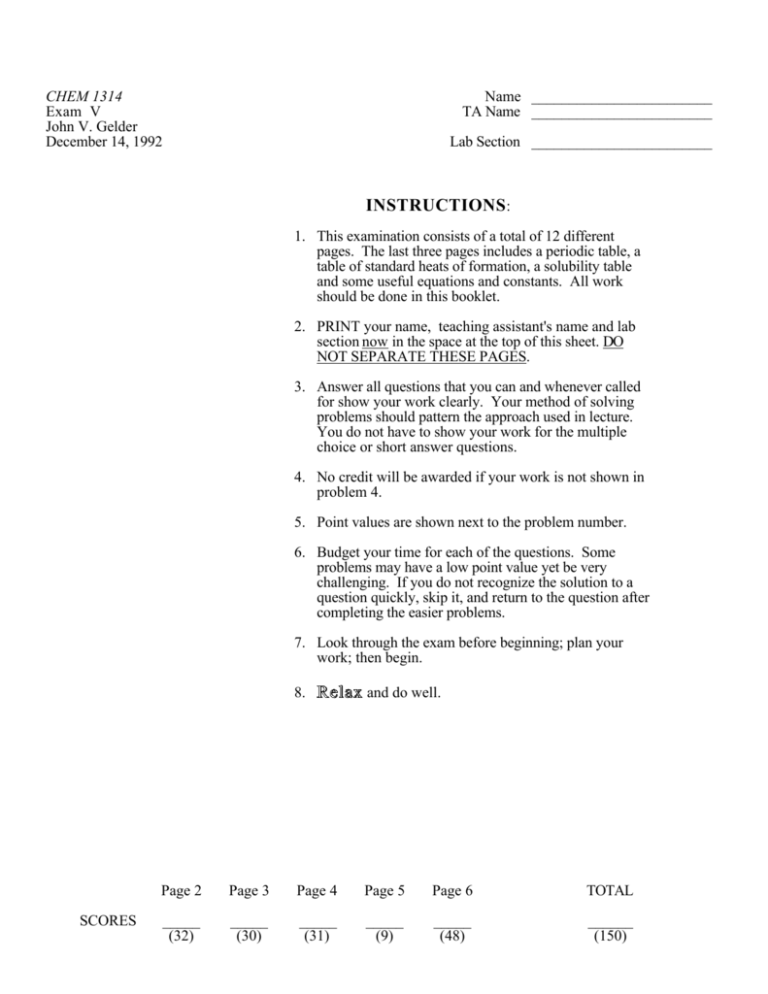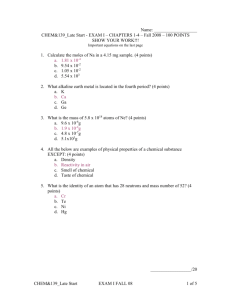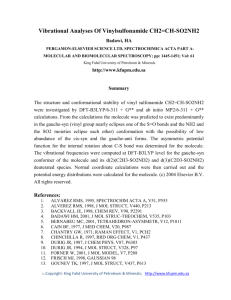Exam V Fall 1992
advertisement

CHEM 1314 Exam V John V. Gelder December 14, 1992 Name ________________________ TA Name ________________________ Lab Section ________________________ INSTRUCTIONS : 1. This examination consists of a total of 12 different pages. The last three pages includes a periodic table, a table of standard heats of formation, a solubility table and some useful equations and constants. All work should be done in this booklet. 2. PRINT your name, teaching assistant's name and lab section now in the space at the top of this sheet. DO NOT SEPARATE THESE PAGES. 3. Answer all questions that you can and whenever called for show your work clearly. Your method of solving problems should pattern the approach used in lecture. You do not have to show your work for the multiple choice or short answer questions. 4. No credit will be awarded if your work is not shown in problem 4. 5. Point values are shown next to the problem number. 6. Budget your time for each of the questions. Some problems may have a low point value yet be very challenging. If you do not recognize the solution to a question quickly, skip it, and return to the question after completing the easier problems. 7. Look through the exam before beginning; plan your work; then begin. 8. Relax and do well. SCORES Page 2 Page 3 Page 4 Page 5 Page 6 TOTAL _____ (32) _____ (30) _____ (31) _____ (9) _____ (48) ______ (150) CHEM 1314 EXAM V (9) (4) PAGE 2 1. Write the chemical formula(s) of the product(s) and balance each of the following reactions. Identify all product phases as either (g)as, (l)iquid, (s)olid or (aq)ueous. + NH 4SCN (s) → a) Ba(OH)2 · 8H2O(s) b) H2SO4(aq) + KOH(aq) → c) Na2CO3(s) + FeCl3(aq) → 2. Write the ionic and the net ionic equation for any one of the equations in Problem #1. (19)3a. Complete the table below by drawing the Lewis electron-dot structures for CH4, NH 3 and H2O, indicating the molecular geometry and the H–X–H bond angle (where X is C, N or O) for each of the three compounds. CH4 NH 3 H2O Lewis Structure Molecular Geometry H–X–H Observed Bond Angle b. Since the electron-pair geometry is the same in all three compounds, explain the trend in the observed bond angle for each compound. CHEM 1314 EXAM V PAGE 3 (30)4a. A 0.3492 g sample of an unknown organic compound containing carbon, hydrogen and oxygen was analyzed and found to contain 55.78% C and 7.04% H with the remainder oxygen. Determine the empirical formula of this compound. b. When a 0.3492 g sample of the unknown organic compound is vaporized at 80.0 ˚C and 750. mmHg it is found to occupy a volume of 120. mL. Determine the molar mass and the molecular formula of the unknown compound. c. If 7.00 g of the compound are combusted with 7.00 g of oxygen, calculate the moles of CO2(g) and H2O(l) formed. CHEM 1314 EXAM V PAGE 4 (10) 5. Define the term ionization energy and indicate the overall trend in the first ionization energy for the elements in a period. Explain why the first ionization energy for an oxygen atom does not adhere to that predicted by the overall trend going across the period. 6. Short answer. (8) a. Complete the following table Name of Compound Formula of Compound Ionic or Covalent ammonium sulfate N2O (2) b. Report the result of the following calculation to the correct number of significant figures. 6.783 x 10 –4 – 8.3 x 10 –6 = (2) c. Name two liquids which when mixed together form a homogeneous mixture. (6) d. How many electrons, protons and neutrons are in the isotope e– _________ (3) e. 34 2– S ? 16 p+ _________no _________ How much energy is required to remove an electron from a hydrogen atom initially in its ground state? CHEM 1314 EXAM V PAGE 5 Short Answer (CONTINUED) (4) f. Give a set of quantum numbers for an electron in one of the 5d orbitals. (2) g. Suggest a formula for a compound containing magnesium and nitrogen. (3) h. How many oxygen atoms are contained in a sample of KAl(SO4)2 with a mass of 2.143 x 10–21 g? CHEM 1314 EXAM V PAGE 6 Multiple Choice: Print the letter (A, B, C, D, E) which corresponds to the answer selected. 7. _________ 8. _________ 9. _________ 10. _________ 11. _________ 12. _________ 13. _________ 14. _________ 15. _________ 16. _________ 17. _________ 18. _________ 19. _________ 20. _________ 21. _________ 22. _________ ONLY THE ANSWERS IN THE AREA ABOVE WILL BE GRADED. Select the most correct answer for each question. Each question is worth 3 points. – 7. What is the concentration of NO3 ions in a solution which is 0.500 M Mg(NO3)2 and 1.00 M Al(NO3)3? A) B) C) D) E) 0.500 M 1.50 M 2.75 M 3.50 M 4.00 M 8. Which of the following species violates the octet rule? A) N2O5 B) O3 C) NO – D) BH4 9. Which of the following statements is false? A) An orbital describes the region of space with the greatest probability of finding an electron. B) The consideration of Heisenberg's Uncertainty Principle and de Broglie's matter waves account for the difference between the behavior of the electron in Bohr's model and the quantum mechanical model of the hydrogen atom. C) Louis de Broglie proposed that particles of matter should be associated with wave-like behavior. D) When an electron in an atom is excited it simultaneously emits a photon of light of the same energy. 10. From the orbital diagrams select an example which demonstrates an atom in its ground state. 1s 2s 2p 3s A. ↑↓ ↑↓ ↑ ↑ B. ↑↓ ↓ ↓ ↓ C. ↑↓ ↑↓ ↑ ↓↑ D. ↑↓ ↑↓ ↓↑ ↓↑ ↓↑ E. ↑↓ ↑↓ ↓ ↑↑ ↑ CHEM 1314 EXAM V PAGE 7 Use the following information to answer Questions 11 and 12. 1.258 g of O2 are mixed with 2.015 g of SO2 are allowed to react at 423 K. After the reaction occurs g 1.728 g of SO 3 are produced according to the equation below. (Note: Molar mass of O2 = 32.0 mol , g g SO2 = 64.0 mol and SO3 = 80 mol .) O2(g) + 2SO2(g) → 2SO3(g) 11. How many grams of O2 remain after the reaction reaches completion? A) B) C) D) E) 0g 0.346 g 0.567 g 0.691 g 0.912 g 12. If the initial pressure of the mixture of oxygen and sulfur dioxide is Pi. Which of the following statements best describes the total pressure exerted by the reaction mixture after the reaction reaches completion? Assume the temperature remains constant in a container of fixed volume. A) B) C) D) Pf is greater than Pi. Pf is less than Pi. Pf is equal to Pi. Not enough information to determine an answer. Use these responses for Questions 13 and 14. A.1s 2 2s2 2p6 3s2 3p5 B.1s 2 2s2 2p6 3s2 3p6 C.1s 2 2s2 2p6 3s2 2d10 3p6 D.1s 2 2s2 2p6 3s2 3p6 3d5 E. 1s2 2s2 2p6 3s2 3p6 4s2 3d3 13. An impossible electron configuration. 14. The ground-state configuration of a negative ion of a halogen. 15. Which of the following gas mixtures exerts the greater pressure? Assume each mixture is in the same size volume at the same temperature A) B) C) D) 2.00 g of H2, 4.00 g of He and 40.0 g of Ar 2.00 g of H2, 6.00 g of He and 40.0 g of Ar 4.00 g of H2, 4.00 g of He and 40.0 g of Ar 2.00 g of H2, 4.00 g of He and 50.0 g of Ar 16. Which of the following are reasonable values for the first four ionization energies for Al? A) B) C) D) 1st 496 kJ 578 kJ 738 kJ 657 kJ 2nd 4562 kJ 1817 kJ 1451 kJ 1269 kJ 3rd 6912 kJ 2744 kJ 7733 kJ 2136 kJ 4th 9543 kJ 11,577 kJ 10,540 kJ 2752 kJ CHEM 1314 EXAM V PAGE 8 17. Consider the exothermic reaction: H2 (g) + I2 (g) → 2 HI (g). Which of the following is true? A) If the reaction occurs at constant pressure ∆H˚ is negative, and ∆H˚ = ∆E˚ B) If the reaction occurs at constant pressure ∆H˚ is positive, and ∆H˚ = ∆E˚ C) If the reaction occurs at constant pressure ∆H˚ is negative, and ∆H˚ ∆E˚ D) If the reaction occurs at constant pressure ∆H˚ is positive, and ∆H˚ ∆E˚ E) ∆H˚rxn = ∆H˚f (HI(g)) 18. Which of the following reactions has a positive ∆H? A) B) C) D) CO2(s) → CO2(g) 2CH3OH(l) + 3O2(l) → 2CO2(g) + 4H 2O(l) 2K(l) + 2H 2O(l) → 2KOH(g) + H 2(g) Na(s) + Cl2(g) → 2NaCl(s) 19. Which of the following diagrams represents a solution of hydrogen and helium at 25 ˚C and 1 atm? A) B) C) D) E) A B C D E 20. Which of the following statements about an ideal gas is false? A) The forces of attraction between gas particles are assumed to be negligible. B) Nonreactive gases will mix in any proportion and behave independently of each other. C) The volumes of the gas particles are assumed to be negligible compared to the volume of the container. D) At a constant temperature, all the molecules are assumed to have the same speed. 21. Which of the following statement is false? A) B) C) D) An exothermic reaction is characterized by a negative value of ∆H. For an endothermic reaction the surrounding to absorb heat. Heat is evolved in an exothermic reaction. Heat is added to the system by an endothermic reaction. CHEM 1314 EXAM V PAGE 9 22. Consider the following specific heats of metals Metal Copper Cobalt Chromium Gold Silver J Specific Heat g·˚C 0.385 0.418 0.447 0.129 0.237 If the same amount of heat is added to 100. g samples of each of the metals, which are all at the same temperature initially, which metal will reach the highest temperature A) B) C) D) E) Copper Cobalt Chromium Gold Silver CHEM 1314 EXAM V PAGE 10 Useful Information Periodic Table of the Elements IA 1 VIIIA 1 2 H He 1.008 3 IIA IIIA IVA VA VIA VIIA 4.00 4 Li Be 2 6.94 9.01 11 12 3 Na Mg 22.99 24.30 19 20 4 5 6 7 5 6 7 8 9 B C N O F Ne 10 10.81 12.01 14.01 16.00 19.00 20.18 13 14 15 16 17 18 IIIB IVB VB VIB VIIB 21 22 K Ca Sc Ti 23 24 25 VIII 26 27 IB 28 Al Si P S Cl Ar 31 33 34 35 IIB 26.98 28.09 30.97 32.06 35.45 39.95 29 30 32 36 V Cr Mn Fe Co Ni Cu Zn Ga Ge As Se Br Kr 39.10 40.08 44.96 47.88 50.94 52.00 54.94 55.85 58.93 58.69 63.55 65.38 69.72 72.59 74.92 78.96 79.90 83.80 37 38 39 40 41 42 43 44 45 46 47 48 49 50 51 52 53 54 Rb Sr Y Zr Nb Mo Tc Ru Rh Pd Ag Cd In Sn Sb Te I Xe 85.47 87.62 88.91 91.22 92.91 95.94 (98) 101.1 102.9 106.4 107.9 112.4 114.8 118.7 121.8 127.6 126.9 131.3 55 56 57 72 73 74 75 76 77 78 79 80 81 82 83 84 85 86 Cs Ba La Hf Ta W Re Os Ir Pt Au Hg Tl Pb Bi Po At Rn 132.9 137.3 138.9 178.5 180.9 183.8 186.2 190.2 192.2 195.1 197.0 200.6 204.4 207.2 209.0 (209) (210) (222) 87 88 89 104 105 106 Fr Ra Ac (223) 226.0 227.0 (261) (262) (263) 58 Lanthanides 59 60 61 62 63 64 65 66 67 68 69 70 71 Ce Pr Nd Pm Sm Eu Gd Tb Dy Ho Er Tm Yb Lu 140.1 140.9 144.2 (145) 150.4 152.0 157.2 158.9 162.5 164.9 167.3 168.9 173.0 175.0 90 91 92 93 94 95 96 97 98 99 100 101 102 103 Actinides Th Pa U Np Pu Am Cm Bk Cf Es Fm Md No Lr 232.0 231.0 238.0 237.0 (244) (243) (247) (247) (251) (252) (257) (258) (259) (260) 1 pound = 453.59237 g 1 L = 1.056718 qt 1 inch = 2.54 cm 9 ˚F = 5 ˚C + 32 ave. atomic mass = ∑ [(isotopic mass)· (fractional abundance)] 1 atm = 760 mmHg J specific heat of water is 4.184 g·˚C ∆H˚rxn = Σ n∆H˚f (products) - Σ m∆H˚f (reactants) q (heat) = mass · specific heat · ∆T 1 En = –RH 2 n c λ= ν K = ˚C + 273.15 ∆H = ∆E + ∆nRT ∆E = q - w Avogadro's number is 6.02 x 1023 RH = 2.18 x 10–18 J m c = 3.00 x 10 8 s E = hν h = 6.626 x 10–34 J·s PV = nRT R = 0.08206 L. atm mol. K CHEM 1314 EXAM V PAGE 11 J R = 8.314 K. mol CHEM 1314 EXAM V PAGE 12 Table of Standard Heats of Formation Substance ∆H˚f and State (kJ/mol) C(s) (graphite) 0 C(s) (diamond) 2 CO(g) -110.5 CO2(g) ? CH4(g) ? CH3OH(g) -201 CH3OH(l) -239 H2CO(g) -116 CCl4(l) -135.4 HCOOH(g) -363 HCN(g) 135.1 CS2(g) 117.4 CS2(l) 89.7 C2H2(g) 227 C2H4(g) 52 CH3CHO(g) -166 C2H5OH(l) -278 C2H5O2N(g) -533 C2H6(g) -84.7 C3H6(g) 20.9 C3H8(g) -104 CH2 = CHCN(l) 152 CH3COOH(l) -484 C6H12O6(s) -1275 TiO2(s) -945 Cl2(g) 0 Cl2(aq) -23 Cl-(aq) -167 H2(g) H(g) H+(aq) OH-(aq) H2O(l) H2O(g) 0 217 0 -230 -286 -242 Substance and State HCl(g) HBr(g) HI(g) I2(g) O2(g) O(g) O3(g) ∆H˚f (kJ/mol) -92.3 -36.4 26.5 62.25 0 249 143 N2(g) NH 3(g) NH 3(aq) NH 4+ (aq) N2H3CH3(l) N2H4(l) NO(g) NO2(g) N2O(g) N2O4(g) N2O4(l) HNO3(aq) HNO3(l) NH 4ClO4(s) 0 -46 -80 -132 54 50.6 90.25 33.18 82.0 9.16 20 -207.36 -174.10 -295 SO2(g) H2S(g) SOCl2(g) S2Cl2(g) -296.83 -20.6 -213 -18 SiO2(s) SiF4(g) SiCl4(g) -910.94 -1614.9 -657 TiCl4(g) TiO2(s) -763 -944.7 CHEM 1314 EXAM V PAGE 13 Solubility Table Ion NO3– ClO4– Cl– I– SO42– Solubility soluble soluble soluble soluble soluble Exceptions none none except Ag+ , Hg22+ , *Pb2+ except Ag+ , Hg22+ , Pb2+ except Ca2+ , Ba 2+ , Sr2+ , Hg2+ , Pb2+ , Ag+ CO32– insoluble except Group IA and NH4 PO43– -OH S2– Na+ NH 4+ K+ insoluble insoluble insoluble soluble soluble soluble except Group IA and NH4 except Group IA, *Ca2+ , Ba 2+ , Sr2+ except Group IA, IIA and NH4+ none none none *slightly soluble + +







